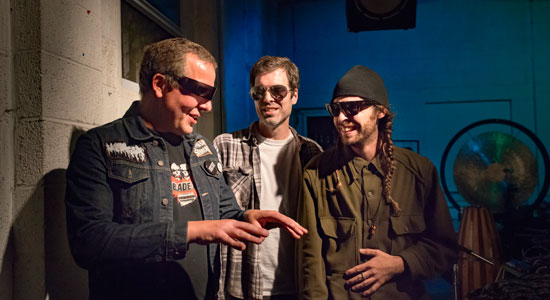
On its near-500th release since forming in 1996, prolific Detroit noise-terrorists Wolf Eyes turn inward and down on Undertow
To hear the members of Wolf Eyes tell it, their short, strange trip from the metallic KO of their 2015 full-length, I Am A Problem: Mind In Pieces, to the uneasy introspection of their latest, Undertow, materialized honestly enough.
“Mind In Pieces was our rock record, and we can’t really out-rock that, you know?” says John Olson, one of the band’s two primary creative forces. “Over the years, we’ve invented our own language to map out our own sonic worlds. And we just keep drawing from that language—there’s a lot of freedom there. We were hanging out with Danny (Ray Thompson) and Marshall (Allen) from Sun Ra’s Arkestra, and they told us they’d wait for months for Sun Ra to bring the band together, then play a traditional thing to show their musical chops. But Sun Ra would be like, ‘I don’t wanna hear that, play as weird as possible!’”
“‘Make it sing like a bird,’” adds Nate Young, the group’s longest-tenured member. “‘Sound like machinery.’ So many cats, when they got to that point in their career, couldn’t do that. It’s so inspiring that Sun Ra looked for people who could. We’re always switching instrumentation and lusting for new sonic worlds. We get some sketches down and then a force comes out and we haunt that force until we feel like our work is done, then zip out of there and check the map for the next available entry point to a new world.”
If its prior album was the experimental collective’s attempt at channeling Blue Cheer by way of Swans, then its latest is an equally sincere effort to run the early jam-based work of Can and Kraftwerk through a Butthole Surfers blender, circa Hairway To Steven. On tracks like “Texas,” woodwinds hover peacefully above the din while white-noise guitar effects and electronic scree sit beneath it all like a primordial ooze draining volubly from a swamp. Others, such as “Thirteen” and the bleak tone-poem title track, convey a sense of a giant ocean liner gliding through a black winter sea: quietly steering its way through terror as icebergs capable of tearing the ship’s hull to shreds loom just beneath the surface. It may very well be the quietest work in the band’s catalog, but it’s not easy listening.
“You could call it downer folk,” says Olson. “Or maybe R&B after the apocalypse. Smokey Robinson and (Robert) Zemeckis hanging out together in a cabin somewhere in Michigan.”
“I consider what we do to be electronic,” says Young. “In my head, I’m always thinking we’re closer to R&B, but really, we’re more like contemporary electronic soul. We’re fans of early Kraftwerk when it was only flute, guitar, bongos and shit. Music at large. Yes, there are noise and found sounds, but we’re attempting to bring musicality to it. Olson brings a different woodwind instrument to practice every day.”
“Nate’s current setup is like a portable musique concrète studio,” says Olson. “The woodwinds just add a three-dimensional aspect to it all.”
“We’re flirting with a lot of sexy sax—we try to go downtown with that shit,” says Young. “We’re not just collecting spare change; we’re straight-up taking cash!”
No matter what the band may have intended, its independent spirit is perfect for the bizarro-world times in which we now live, its ethos and seemingly tireless work ethic having produced a new imprint (Lower Floor Music) in which music both created and curated by Wolf Eyes will be issued in new and archival versions. If any of this reminds you of, say, SST Records back in its prime, there’s more than a passing similarity between the DIY punk ethos that ruled/bucked against the limitations of the Reagan era and the group’s commitment to doing the same in the age of Trump.
“It’s one thing to invent your own words, quite another to use them in a sentence in your own way,” says Olson. “The book of our band could be 60 pages, or 18 volumes. You don’t always have to read the whole thing, but it’s there. Thirty years from now, we’ll all be glad there’s these tapes and a thousand ways to define our sound rather than whatever some label told us they could do.”
“I’ve read Ron Asheton interviews where at some of the earliest Stooges gigs—the Psychedelic Stooges!—there were pieces of sheet metal and some tap dancing shoes or a vacuum cleaner being fed through a reverb pedal,” says Young. “Our other genre is ‘revolt!’”
—Corey duBrowa






